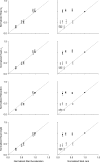Head and neck control varies with perturbation acceleration but not jerk: implications for whiplash injuries
- PMID: 19237420
- PMCID: PMC2683968
- DOI: 10.1113/jphysiol.2009.169151
Head and neck control varies with perturbation acceleration but not jerk: implications for whiplash injuries
Abstract
Recent studies have proposed that a high rate of acceleration onset, i.e. high jerk, during a low-speed vehicle collision increases the risk of whiplash injury by triggering inappropriate muscle responses and/or increasing peak head acceleration. Our goal was to test these proposed mechanisms at realistic jerk levels and then to determine how collision jerk affects the potential for whiplash injuries. Twenty-three seated volunteers (8 F, 15 M) were exposed to multiple experiments involving perturbations simulating the onset of a vehicle collision in eyes open and eyes closed conditions. In the first experiment, subjects experienced five forward and five rearward perturbations to look for the inappropriate muscle responses and 'floppy' head kinematics previously attributed to high jerk perturbations. In the second experiment, we independently varied the jerk ( approximately 125 to 3 000 m s(-3)) and acceleration ( approximately 0.65 to 2.6 g) of the perturbation to assess their effect on the electromyographic (EMG) responses of the sternocleidomastoid (SCM), scalene (SCAL) and cervical paraspinal (PARA) muscles and the kinematic responses of the head and neck. In the first experiment, we found neither inappropriate muscle responses nor floppy head kinematics when subjects had their eyes open, but observed two subjects with floppy head kinematics with eyes closed. In the second experiment, we found that about 70% of the variations in the SCM and SCAL responses and about 95% of the variations in head/neck kinematics were explained by changes in perturbation acceleration in both the eyes open and eyes closed conditions. Less than 2% of the variation in the muscle and kinematic responses was explained by changes in perturbation jerk and, where significant, response amplitudes diminished with increasing jerk. Based on these findings, collision jerk appears to have little or no role in the genesis of whiplash injuries in low-speed vehicle crashes.
Figures








References
-
- Allum JHJ, Gresty M, Keshner E, Shupert C. The control of head movements during human balance corrections. J Vestib Res. 1997;7:189–218. - PubMed
-
- Blouin JS, Descarreaux M, Bélanger-Gravel A, Simoneau M, Teasdale N. Attenuation of human neck muscle activity following repeated imposed trunk-forward linear acceleration. Exp Brain Res. 2003a;150:458–464. - PubMed
-
- Blouin JS, Descarreaux M, Bélanger-Gravel A, Simoneau M, Teasdale N. Self-initiating a seated perturbation modifies the neck postural responses in humans. Neurosci Lett. 2003b;347:1–4. - PubMed
-
- Blouin JS, Inglis JT, Siegmund GP. Auditory startle alters the response of human subjects exposed to a single whiplash-like perturbation. Spine. 2006a;31:146–154. - PubMed
Publication types
MeSH terms
LinkOut - more resources
Full Text Sources

